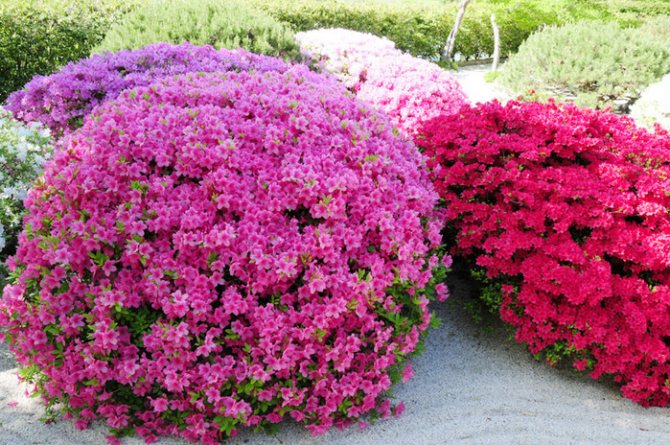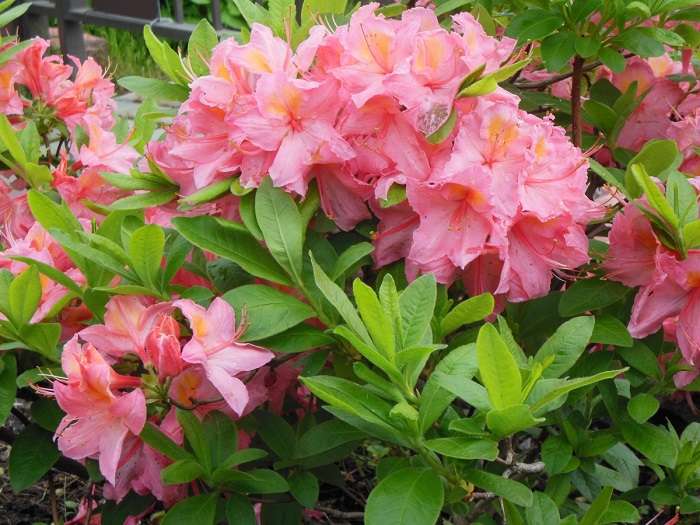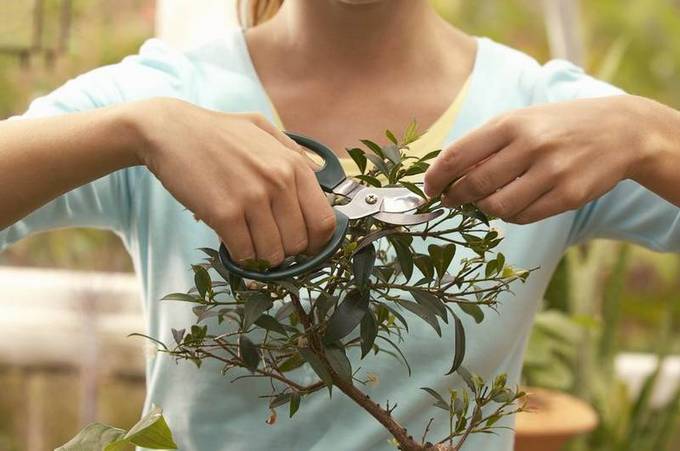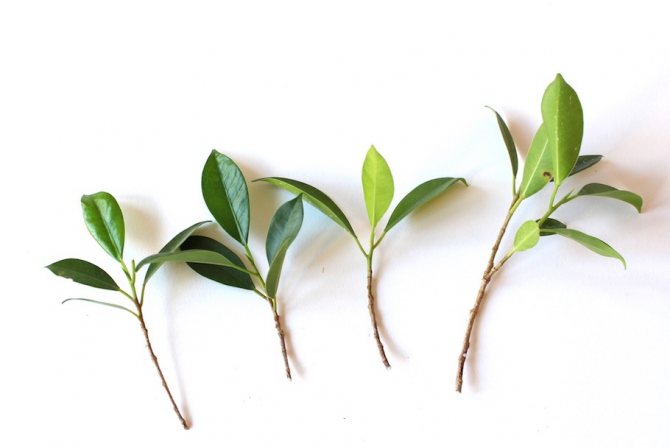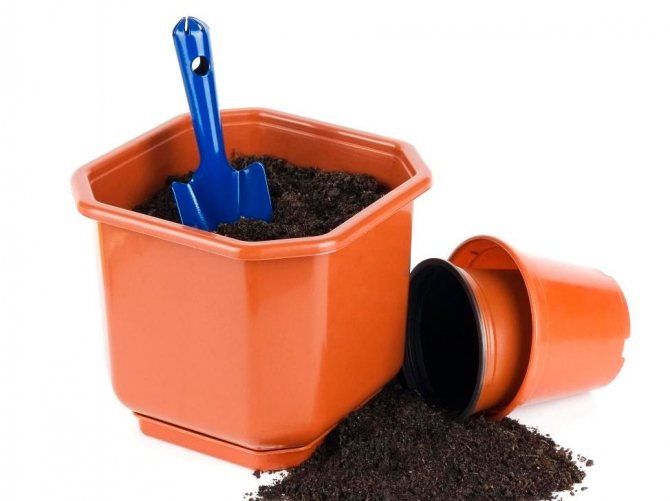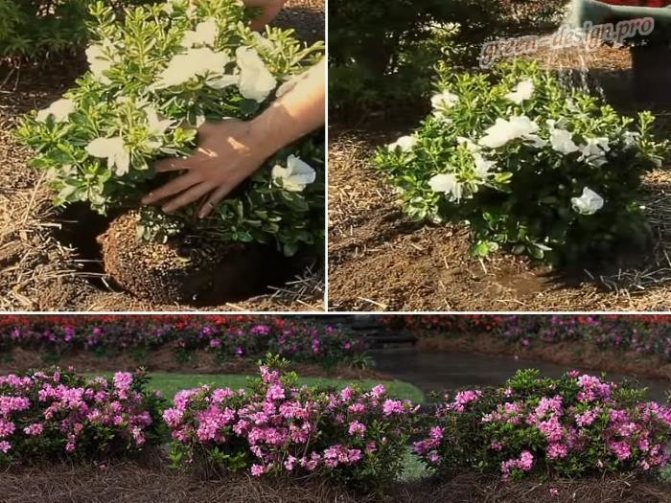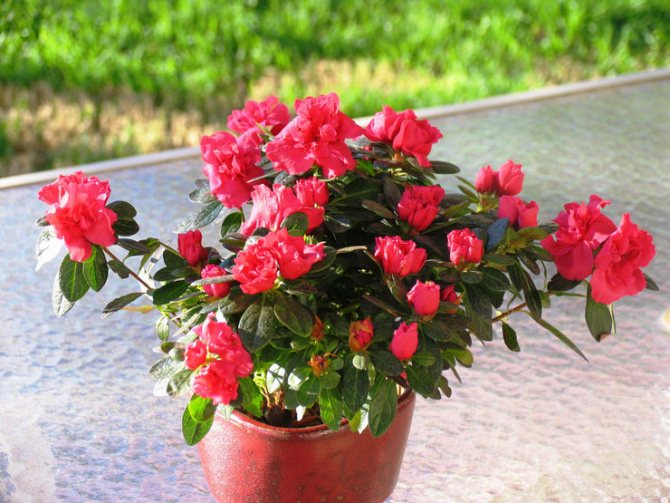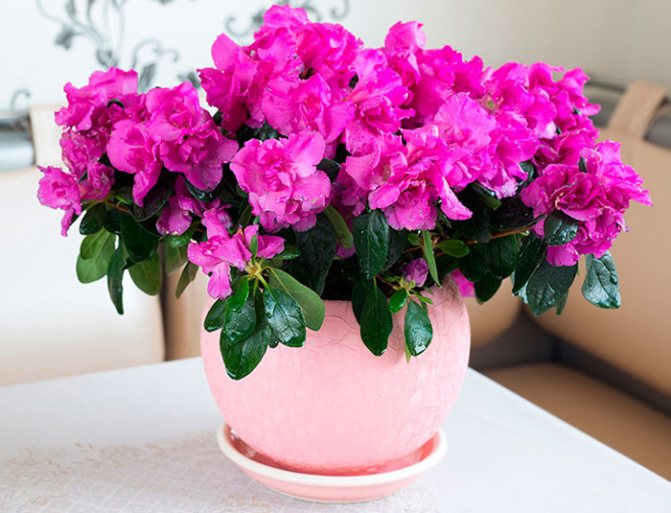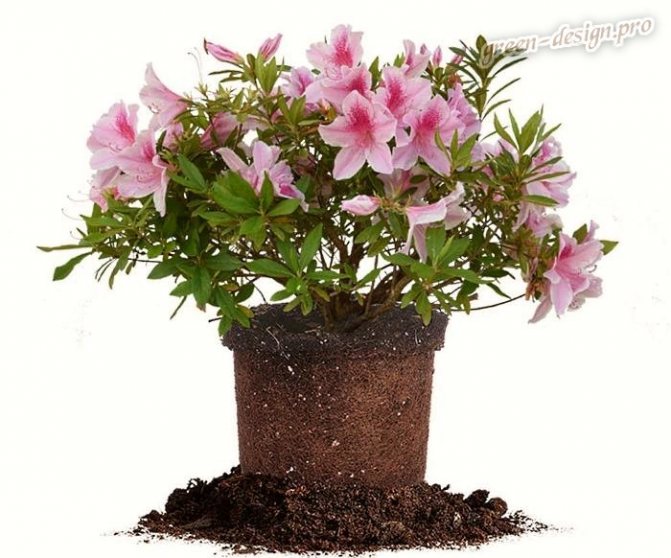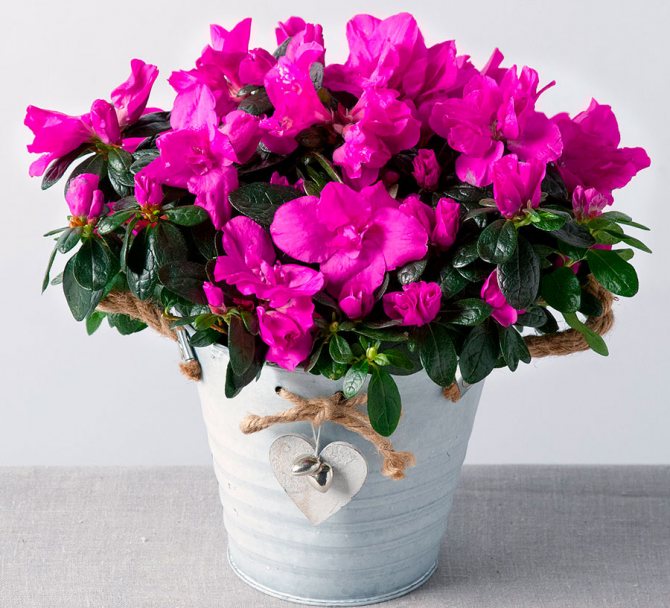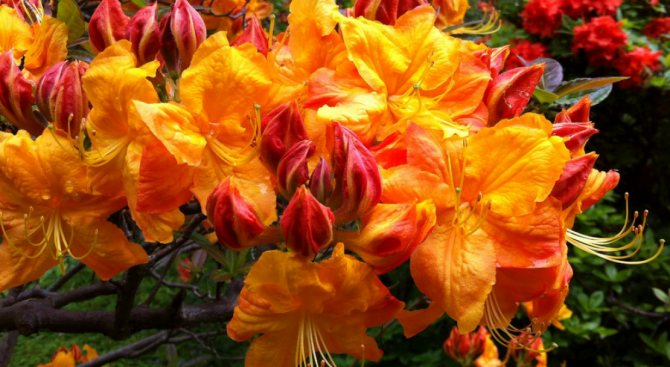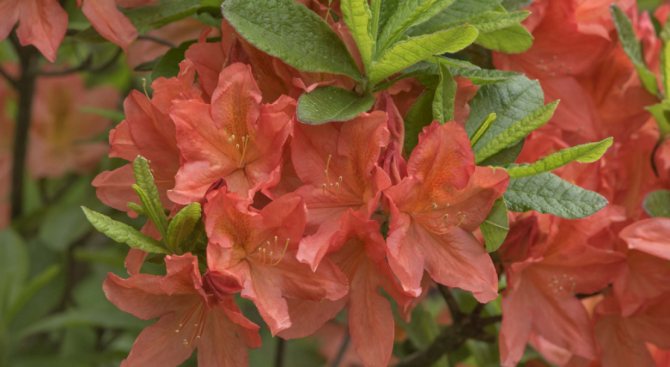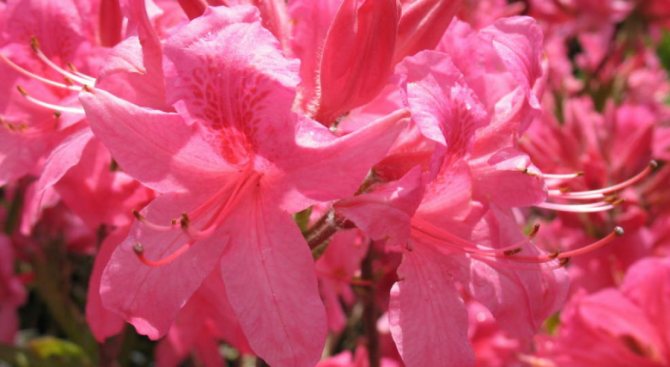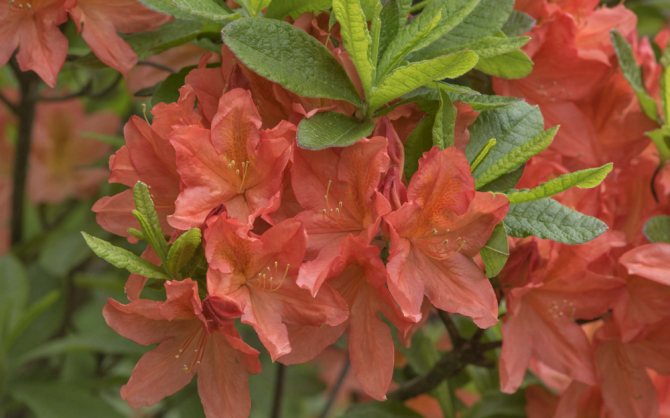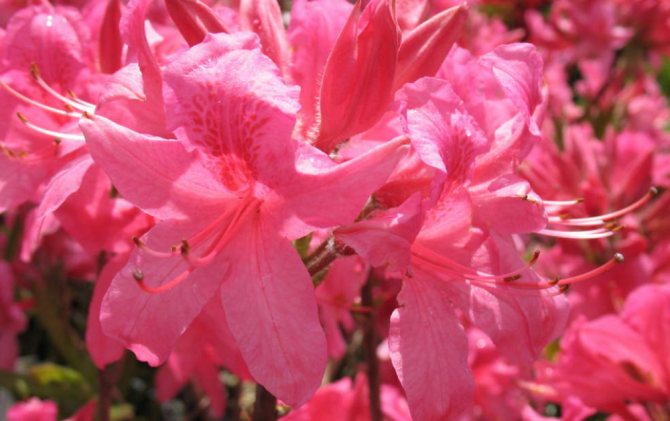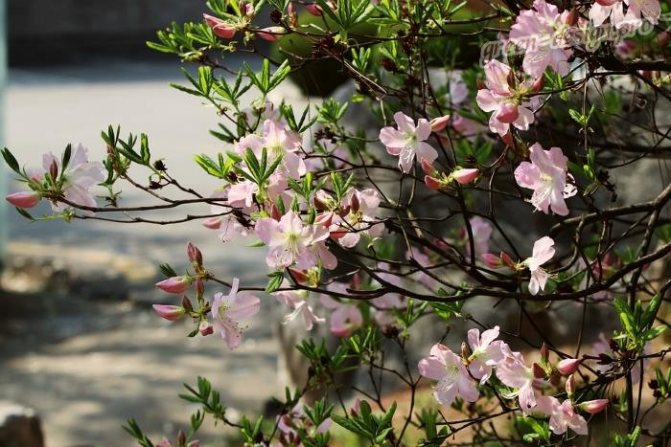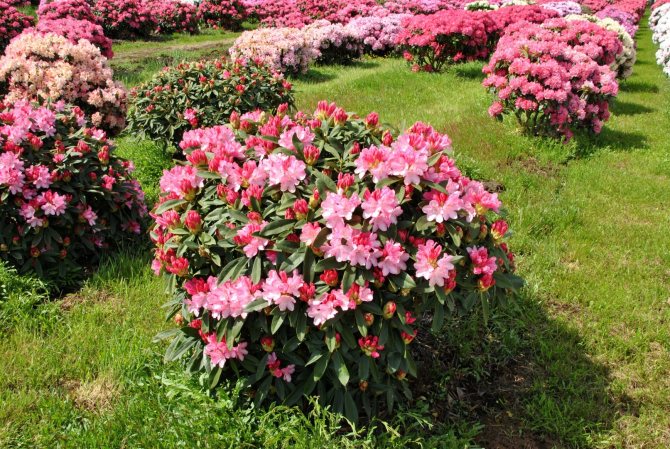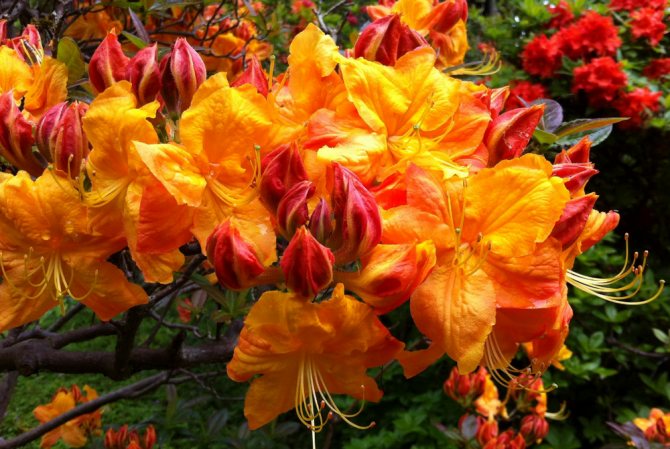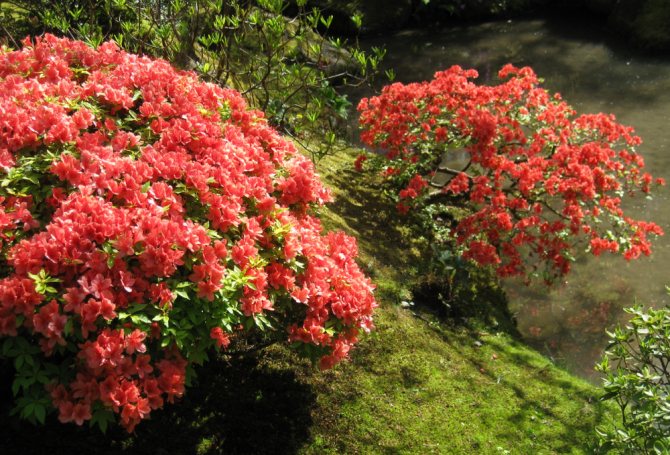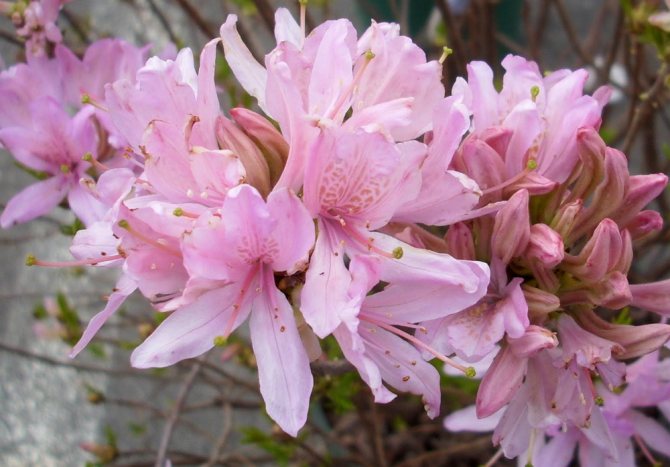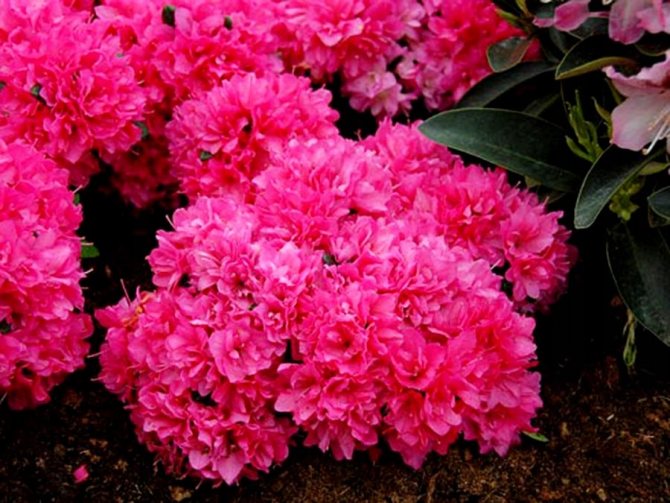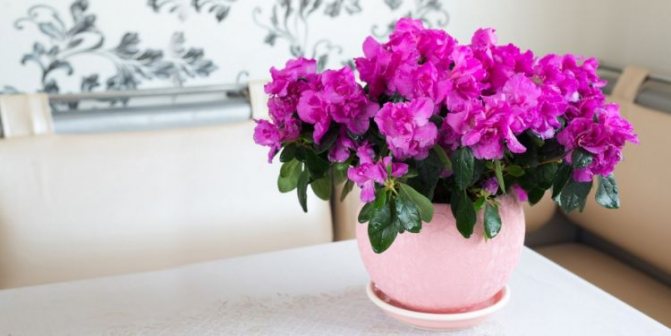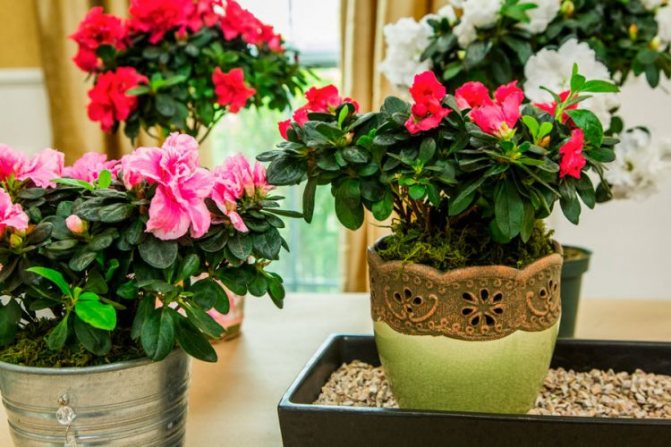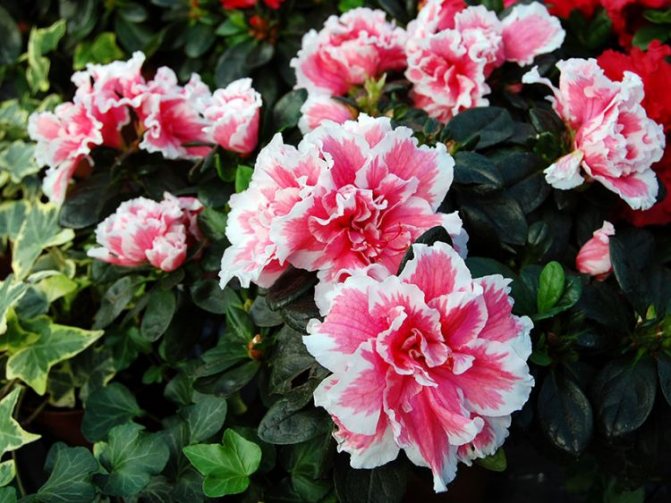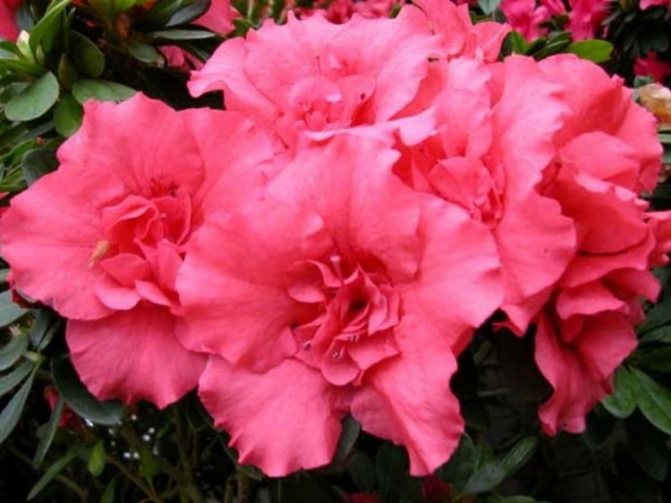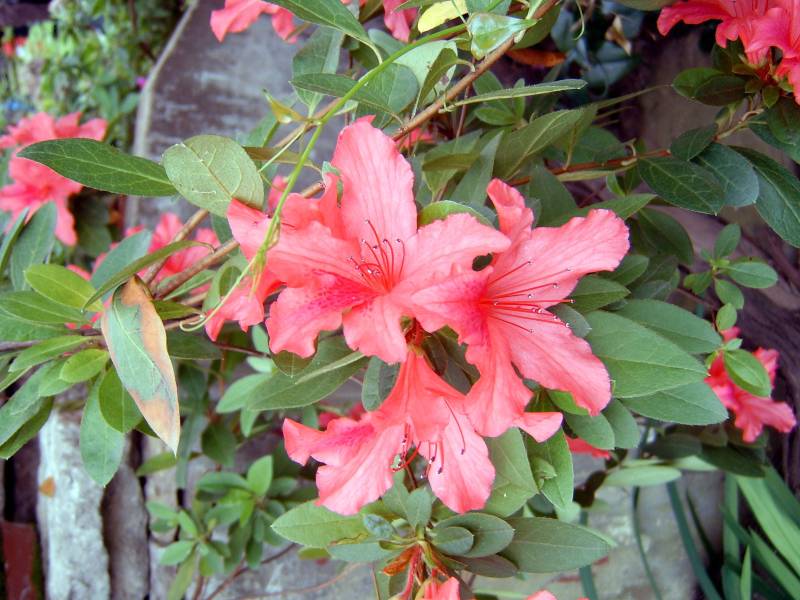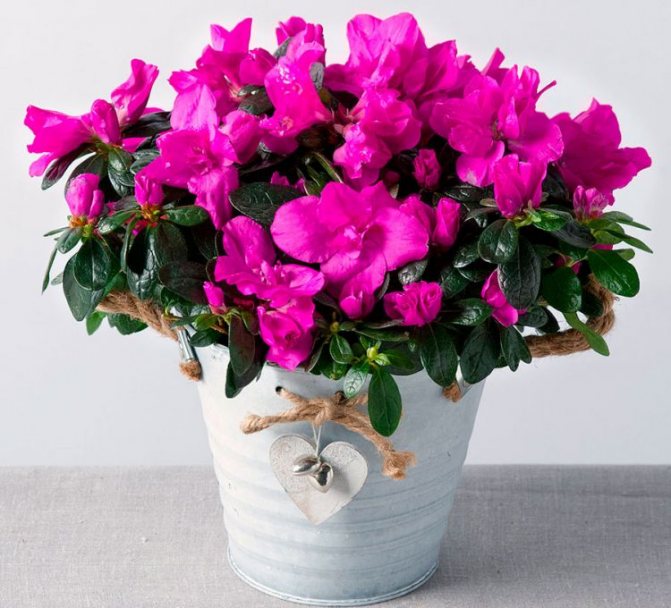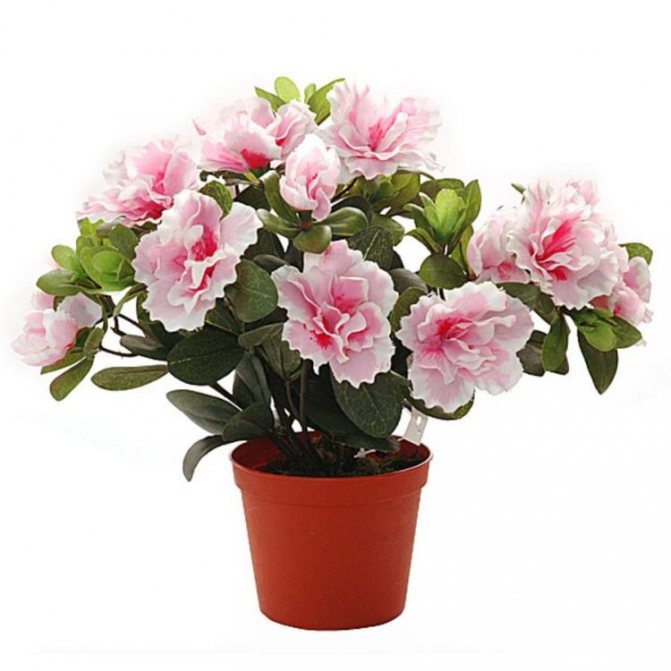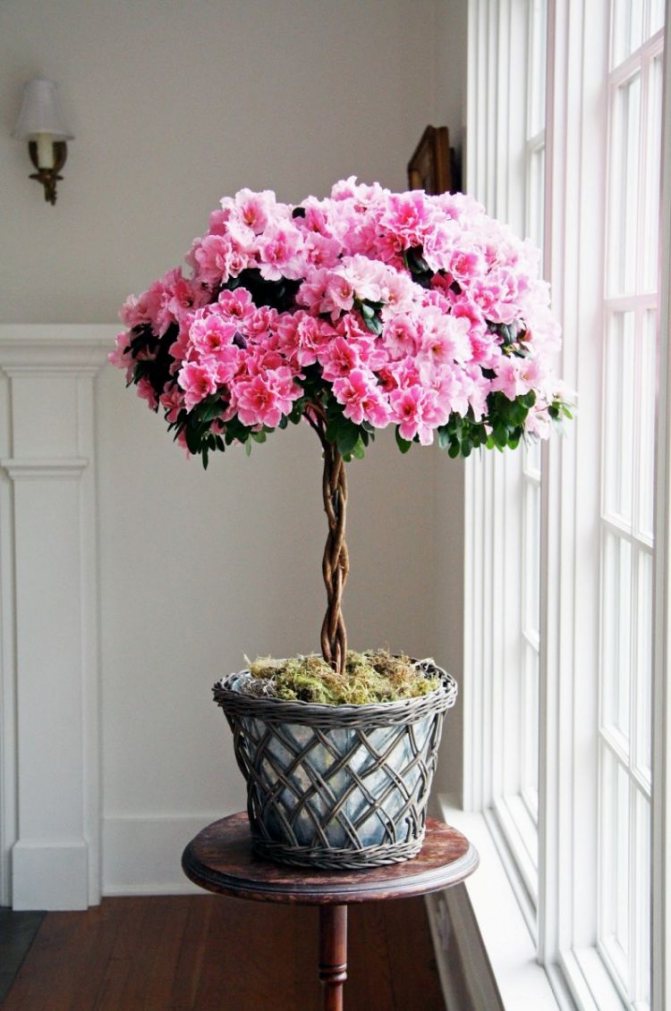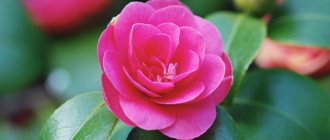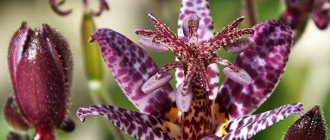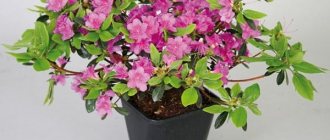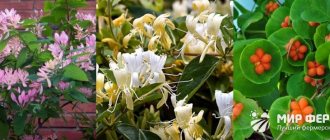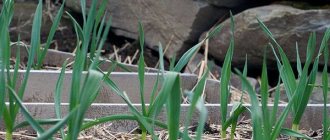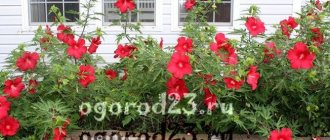Popular species and varieties
Among the types of high decorativeness, large-flowered and Japanese azaleas are popular.
Deciduous (large-flowered) varieties are characterized by high growth and large flowers of various shapes. The flowering period is late May and early June. The most popular winter-hardy varieties: Chanel, Freya, Klondike, Tunis, Sonya, Starus, golden Golden Lights and Golden Sunset, one of the most beautiful varieties of late flowering bright orange Gibraltar ".
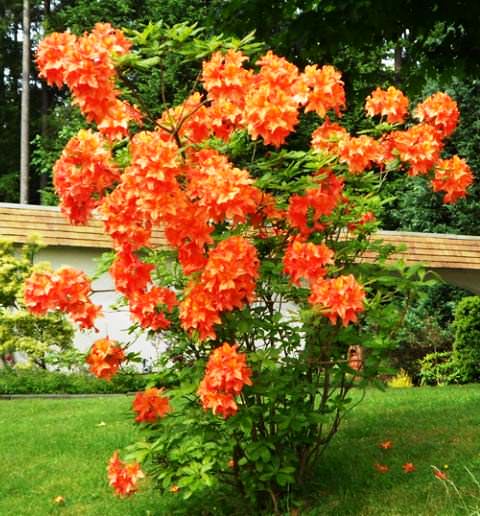
Variety "Gibraltar"
Japanese azaleas are characterized by slow growth and a more compact form of bush not exceeding 60-100 cm. There are dwarf varieties not exceeding 30 cm in height. The shrub grows more in breadth than upward, so it can be used as a ground cover. Flowers delight gardeners with all shades of pink, lilac and purple. Leaves usually fall off in the winter, but not in all varieties. Several popular varietal forms: "George Arendés", "Kermezina", "Rosinetta", "Silvester", "Rubinstern", "Marushka", "Blue Danube".
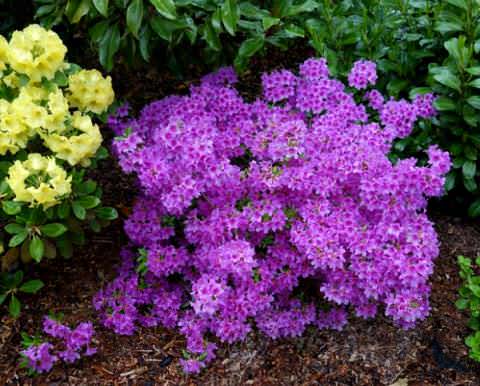

Variety "Blue Danube"
The duration of flowering, depending on the species and variety, varies from 3 weeks to 2 months, and the first time the culture blooms for 3 years.
Diseases, pests and control of them
Fungal diseases of deciduous rhododendron appear due to an incorrectly chosen place for plant cultivation, the settlement of a bush with harmful insects. The crop can be affected by rust, sometimes spotting appears on the leaves. For prophylactic purposes, shrubs should be sprayed with copper-containing preparations.
Important! The occurrence of chlorosis symptoms on the foliage of rhododendron bushes is caused by an increased content of lime in the soil.
The crop can be damaged by various pests:
- mealybugs;
- scabbards;
- spider mites;
- bedbugs;
- weevils;
- rhododendra flies;
- slugs and snails.
Regular inspections of shrubs are recommended. To get rid of insects, insecticides and acaricides of a wide spectrum of action should be used. For example, you can use "Karbofos".


Deciduous rhododendron is a compact, perennial shrub that blooms profusely in early summer. It retains its decorative effect throughout the growing season due to the change in foliage color with the arrival of autumn. During the flowering period, many inflorescences are painted in bright colors, have a delicate aroma.
Growing rules
Choosing garden soil and planting azaleas
Cultivation of azaleas requires the creation of appropriate conditions and an important factor necessary for successful cultivation is, first of all, the substrate that ensures the correct development of the shrub and the intensity of flowering. The plant belongs to acidophilic crops, which require an increased level of soil acidity, approximately 3.5 - 4.5 pH.
Before planting azaleas in garden soil, you need to properly prepare it. After digging a hole to a depth of 40-50 cm, the extracted soil is mixed with components that increase acidity - peat and compost based on needles or crushed bark of coniferous trees, taken in equal proportions.
For good water permeability, add 2 parts of coarse sand and spread a high drainage layer of expanded clay and sand on the bottom.You can immediately purchase ready-made soil for azaleas and rhododendrons.
When planting a plant, be careful with the roots so as not to damage the beneficial mycorrhiza (fungus root with a symbiosis of fungus and roots) living on the root system of azaleas, rhododendrons, hydrangeas, etc. soil and climatic conditions.
The plant is planted in a prepared hole by transferring so that the surface of the root ball is only slightly below the soil level. The earth is compacted around.
After planting the azaleas in the garden soil, the bush is well watered and the soil around it is covered with a thick layer of garden pine bark mulch, which has a beneficial effect on the development of the shrub: it maintains the acidity of the soil, improves its structure, protects the root system from drying out, and prevents the growth of weeds.
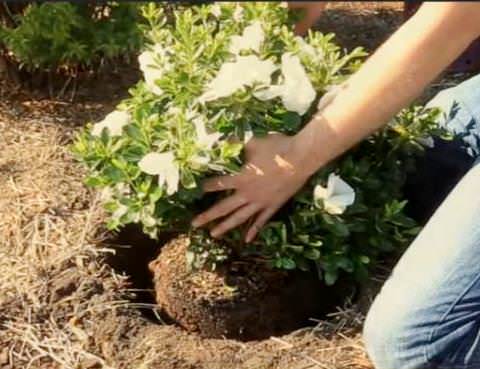

Before planting a shrub, read the information about the height and width of the selected variety. The garden azalea is a long-lived and slow-growing plant, so consider the future size of your plantings to give them enough room to grow. Usually the distance between large bushes is 1-1.5 meters, and between small Japanese varieties - 0.5-0.7 m. You can plant container plants from the nursery all season - from April to early October.
Location selection
In caring for garden azaleas, it should be borne in mind that plants love partial shade and do not react well to the midday sun, which causes flowers to drop, foliage wilting and a decrease in flower buds. Shrubs grow best under the crowns of trees, especially conifers: pines, spruces, larch trees, as well as next to any bodies of water that provide air humidity.
The best place for them will be a place protected from the wind. Windy areas increase the negative impact of low temperatures and dry out the soil, often leading to the death of plantings.
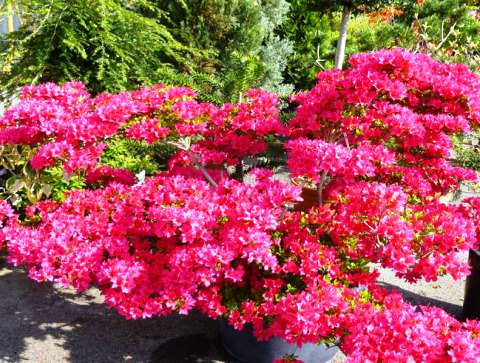

Sort "Silvester"
The culture has a shallow root system, so it cannot extract water from deeper layers of the soil and quickly floods with poor drainage. For this reason, it is important to choose a position where the plant will not be severely affected by drought and heat, and at the same time will not be exposed to root flooding.
How to water
Outdoor care for azaleas involves frequent but moderate watering and spraying of foliage in hot weather. The shrub loves slightly moist soil and does not tolerate its drying out.
It is best to water in the early morning or late evening, not very abundantly, using cool rain or soft water. The frequency of watering is about once every 2 days as the top layer of the soil dries up, in the heat it is watered every day. Since September, the frequency of watering is reduced.
Preparing for winter
To prepare for winter, especially for azaleas with evergreen leaves, it is very important to moisturize the soil well in the fall, before the onset of frost. After watering the substrate, lay a layer of 10 to 30 cm (depending on the height of the bush) around the bushes of compost pine bark, peat and oak leaves to protect the roots from drying out and temperature changes. In spring, this mulch will enrich the soil with valuable humus.
In regions with harsh winters, choose deciduous varieties that are resistant to very low temperatures. In varieties sensitive to cold, the ground part of the bushes is insulated with the help of agrofibre or special frames insulated with spruce branches or roofing material. With the onset of spring heat, the shelter is immediately removed.
How to fertilize
In the first year after planting, the plants do not need additional fertilization, but in subsequent years, the plantings should be regularly fed with fertilizers for acidophilic plants (heather, erica, camellia, rhododendron) in accordance with the instructions.
Since azaleas are sensitive to the salinity of the substrate, it is better to use granular dressings with a delayed effect, slightly dripping them around the bush at a distance of 20 cm from the center. Conventional liquid fertilizers are fed for the first time in early spring, and then every 2 months, they are diluted in water for irrigation.
The last dose of fertilizer should be applied by the end of July. Spring dressings should contain elements such as nitrogen, potassium and phosphorus in equal proportions; after flowering, phosphorus-potassium fertilizers are applied.
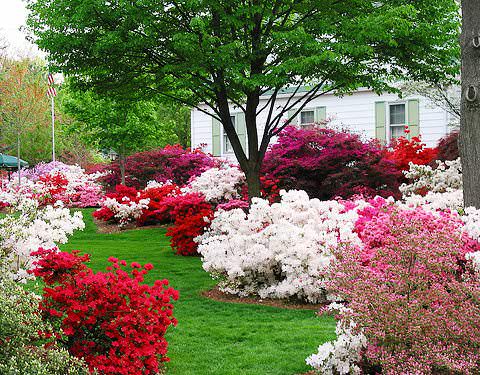

It should be remembered that azaleas are unable to absorb iron, as a result of which they begin to suffer from leaf chlorosis. This is very common in acidophilic plants, so it is important to maintain the acidity of the substrate.
Nitrogen deficiency is manifested by yellowing of the leaf and a decrease in size, while phosphorus deficiency is manifested by darkening of the leaves, loss of gloss, brown spots appear in the area of the central vein. If we observe the yellowing of the edge of the leaves and their curling upward, then this is a reaction to potassium deficiency.
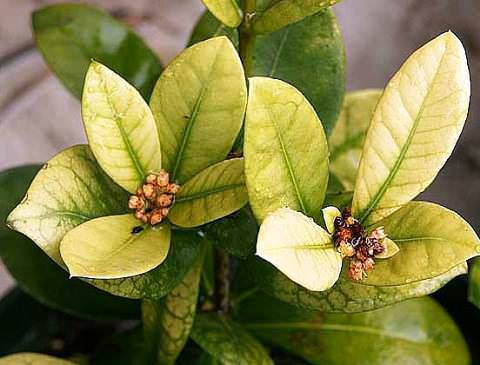

Azalea chlorosis
Pruning azalea
Garden azalea does not require radical pruning - it is enough to remove diseased, deformed, damaged and too long branches. If the bush is heavily thickened, then it is thinned out to provide access to light, air circulation and improve its appearance. It is important that pruning is carried out no later than 3 weeks after flowering, before the buds are laid.
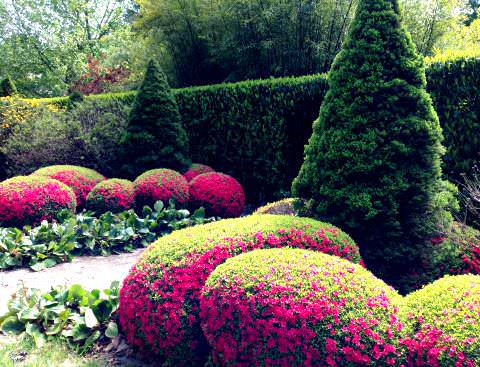

Azalea topiary figures
You should also regularly get rid of faded buds to keep blooming profusely. For decorative purposes, azaleas, especially Japanese ones, are perfect for creating topiary figures.
How to propagate an azalea outdoors
The most common and effective methods are cuttings and layering.
Propagation using apical cuttings of azaleas
Evergreen varieties take root best. The rooting process of deciduous forms is limited in time, since cuttings taken from young shoots of the new season that have not completed their development are suitable for the procedure. The leaves on such cuttings are still small, light green, the vegetation bud continues to grow. Rooting will not occur on old shoots. Cuttings are harvested at the end of June. In evergreen varieties, the tops of the shoots can be taken until the end of July, immediately after flowering.
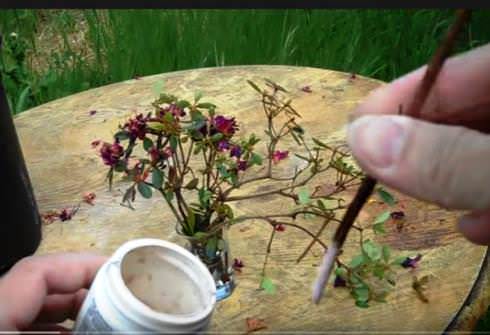

Dip the cuttings into powder for root formation
The length of cut cuttings is 15-20 cm. We remove extra leaves and lateral branches, faded inflorescences from them. Before diving into the substrate, the cut of the cuttings is dipped into a powder that stimulates the formation of roots.
Then we plant in a mixture of equal parts of perlite, peat and humus soil. Water well with a shower head and place the pots in a clear plastic bag to create a greenhouse environment.
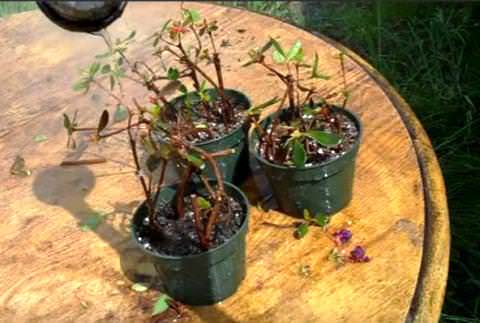

Water the cuttings well
We put the pots in partial shade so that the sun hits the cuttings in the morning or evening. From time to time we remove the package for watering and airing. The substrate must be moist, not wet, otherwise the cuttings will rot.
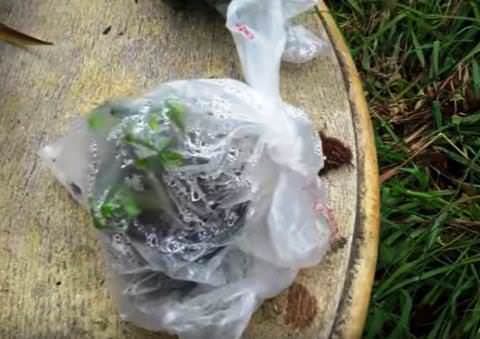

Greenhouse for cuttings
The formation of young leaves is a sign of successful rooting. In mid-September, young seedlings can be planted in open ground and for the first 2 years they can be covered for the winter with a layer of foliage, spruce branches and a lot of snow.
Reproduction by layering
Low bushes with long side shoots are most suitable for this breeding method. In the spring, we tilt the shoots to the ground and fasten them in a special shallow hole in the form of a trench. We fall asleep with fertile soil and water it regularly. The next year, the layer should give a new shoot, after which we cut it off from the mother bush and plant it as an independent young plant.
Problems in the care of garden azaleas in the open field
The culture, like other plants, is vulnerable to pests and diseases. Most often, fungal diseases develop caused by excess moisture:
- leaf spot, when brown spots of various sizes appear on the leaves, bearing spores of the fungus;
- late blight, which is manifested by drying and death of shoots;
If diseases develop, the plant must be treated with fungicidal preparations, which work well as preventive measures.
Garden azalea is often affected by such pests as: a dangerous rhododendron bug, aphids, a strawberry mite that damages flowers, buds and young leaves, a weevil and its larvae, an azalea moth. From pests, it is necessary to treat the plantings with special insecticides.
Application in garden design
Azaleas are ideal for Japanese and Chinese-style gardens. They look spectacular against the backdrop of the lawn, creating picturesque groups. They can be planted both in large gardens and in small areas. Plantings look great in a company with any conifers, heather, camellias, decorative deciduous barberry, euonymus, Japanese maples, hydrangea, weigela.
Azalea is one of the most beautiful shrubs, belongs to the heather family. In the modern classification, azalea is ranked among the genus of rhododendra plants. There are evergreen and deciduous varieties of the garden azalea.
This beautiful shrub is native to Japan, China and North America. In Japan, azalea is even one of the national symbols.
It has been cultivated on the territory of Russia for two centuries. Breeders have obtained winter-hardy varieties, which are successfully grown in regions with a cold climate.
Such varieties of azaleas are able to survive frosts down to -27 degrees. There are garden varieties of azaleas and varieties specially bred for indoor maintenance.
Azalea blooms magnificently and for a long time. Flowers are so densely arranged on the branches that you can't even see the leaves. Blooming azalea with its colorful, festive look can improve mood, its contemplation calms and pacifies.
Azalea is believed to be a plant that protects and enhances family happiness. Planted in the garden or at home, azalea helps to unite all family members.


Prevention of various problems
- Nabucco azalea leaves darkened, began to fall off - incorrect watering, it is necessary to adjust it.
- If the leaves turn yellow, the flower lacks nitrogen, magnesium or iron. The process of photosynthesis is disrupted, the leaves become pale. Be sure to need fertilizing with complex fertilizers.
- In summer, the leaves shriveled and spots appeared on them - you need to increase the humidity of the air, "cool" the flower with ice, shade the windows, especially at lunchtime.
Breeding azalea Nabucco requires knowledge, skill and effort. But if you follow all the rules for caring for an exotic, cut it off and feed it in time, you can expect its generous flowering.
If you find an error, please select a piece of text and press Ctrl + Enter.
Description of the plant
Azalea bushes can be from 30 cm to 3 m in height, depending on the variety. The leaves are small, elliptical. Flowers have the shape of a funnel, they are double and simple, monochromatic and two-color.
The color of different varieties is different, but always bright - white and pink, raspberry and lilac, yellow and orange, red and even blue. Flower buds are laid on last year's shoots.
The beginning of flowering of a garden azalea and its duration also depend on the type of plant: early flowering - in December, mid-flowering - in February, late flowering - in April. Flowering lasts from 2 weeks to 2 months. The shrub is slow growing.
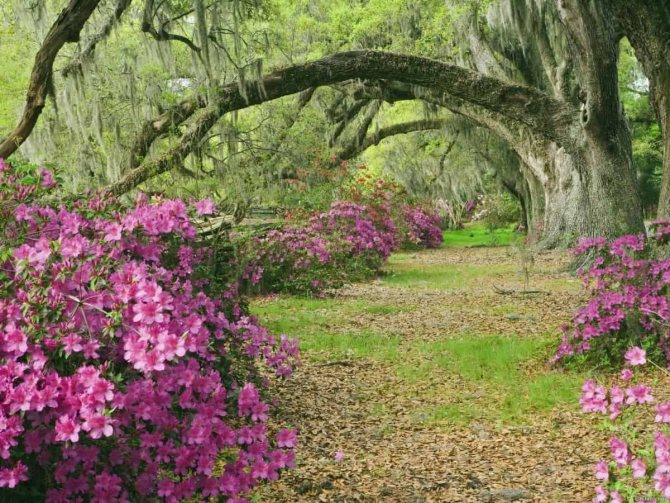

Subsort
Kamchatka
Photo:
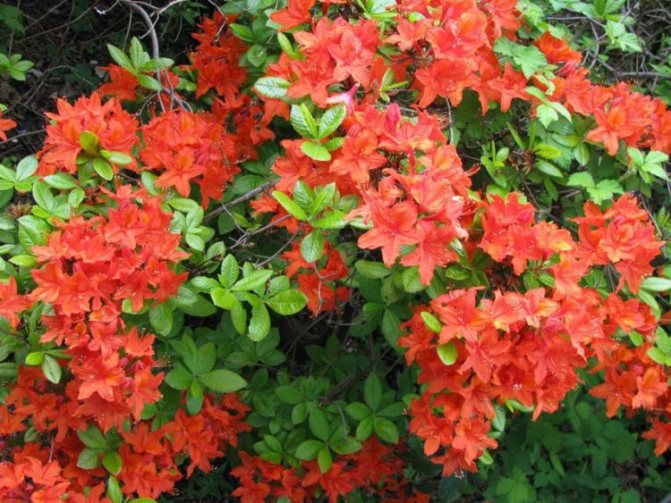

The bush spreads on the surface of the soil, is a deciduous variety.The flowers are large and bloom in June. Flowering is not numerous, but rather long. In autumn, the leaves turn bright orange-red before shedding their leaves. In nature, this species grows in Kamchatka, Alaska and Japan. Loves light and is well adapted to cool areas.
You can read more about the Kamchatka rhododendron here, and in this article we talked about the azalea of the Lights series.
Arabesque
Photo:
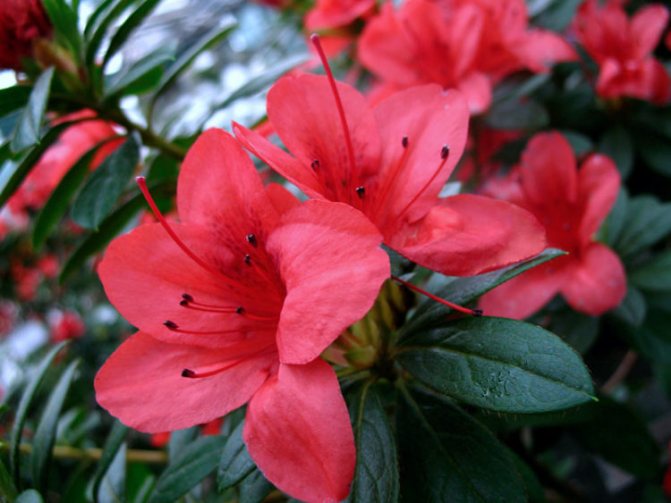

This variety is distinguished by its extraordinary brightness of flowering. The flowers are bright red, have an average size of 4 - 5 cm. Blooms in mid-May. Leaves are glossy, elongated, of medium size. The variety itself is low, grows slowly, always looks like a neatly growing ornamental bush. In winter, the leaves change color, becoming dark - burgundy.
Fireball
Photo:
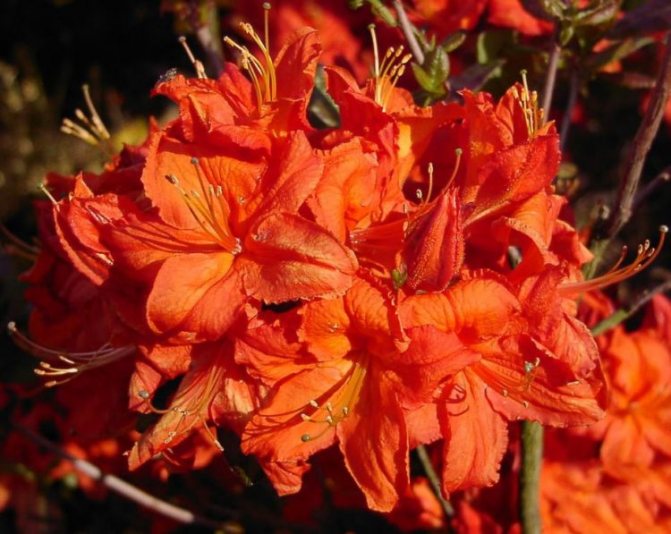

This subspecies belongs to deciduous shrubs. Leaves are oblong, medium. When blooming, they have a bronze tint, then turn dark green. In autumn, they change color to red, with a raspberry tint. In autumn they acquire a bright orange color. Blooms in early June. The bloom is violent, the flowers themselves are fiery red, large enough - 6 - 7 cm in length. The flowers are in the shape of a bell or a small cup. It is considered a frost-resistant fast-growing hybrid of azaleas.
Azalea varieties
Azaleas have two main varieties - Japanese evergreen and deciduous.
The most popular evergreen Japanese azaleas are:
- Adonis. The bush has strong shoots and a rounded crown. The flowers are snow-white. It is necessary to choose the right place for planting, does not tolerate the bright sun and drafts.
- Drapa. It is a newly developed late-blooming variety with charming lilac-pink flowers that delight the eye for three weeks.
- Melina. Dwarf variety, no higher than 30 cm in height and 50-60 cm in width. It blooms with crimson-pink flowers, collected in dense inflorescences. Prefers moisture and coolness.
- Konigstein. Bushes are low and slow growing, no more than 0.5 m in height. It blooms from the end of May with purple-violet flowers with dark veins.
- Blauves Pink. A dwarf shrub that grows up to 80 cm in height. It blooms in May-June with salmon-pink flowers. Sometimes sheds leaves partially.
- Weeks Scarlet. A dwarf variety, no higher than 60 cm, can be grown in pots at home. Blooms in May-June with red-orange flowers.
- Geisha Orange. The bush is of medium height, about 1 m, fast growth and high winter hardiness. The flowers are of an unusually beautiful bright orange color.
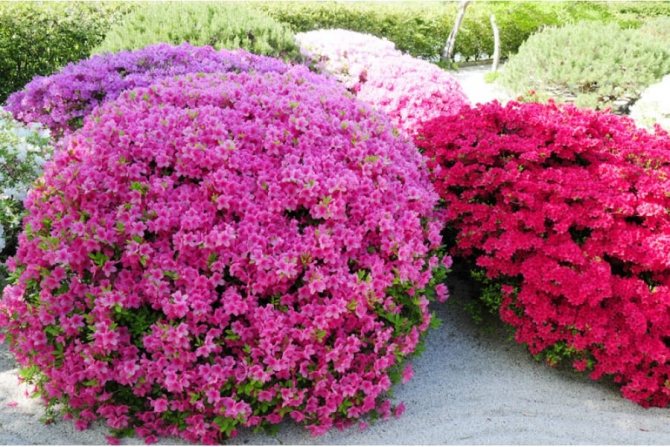

Among the deciduous azaleas, the following varieties are best known:
- Golden Lights. A frost-resistant shrub 1.5 m high, with very beautiful golden yellow flowers, blooms in May-June. Prefers abundant watering and acidified, humus-rich soils.
- Koichiro Wada. Possesses high frost resistance, reaches a height of 1.4 m, has bowl-shaped flowers, which, in the process of development, turn from pink to snow-white.
- Satan. Bushes are tall, 1.8 m, blooms in May-June with scarlet simple flowers. Well-lit areas with loose soil and good drainage are preferred.
- Czardas. Begins to bloom in May, flowers are double, an unusual yellow-cream shade. Prefers areas brightly lit by the sun.
- Slavka. The bushes are 1-1.4 m high, the flowers are double, snow-white in color, the crown is spherical.


Transplant rules
The reason for the unsatisfactory condition of the bush may be an incorrectly selected place. This situation can be corrected by moving the deciduous rhododendron, especially since this procedure promotes the growth of young shoots and the formation of lush inflorescences. Early spring or late autumn is considered a favorable period for transplanting. It is not recommended to carry out this event during the flowering of the bush. For the purpose of transplanting, the bush should be delicately dug up.
Also read about how to deal with pests and diseases of rhododendrons.
In this case, it is necessary to take into account the superficial distribution of the root system, mainly in width, rather than in depth. The shrub is removed simultaneously with the earthen lump and moved into a pre-prepared recess. The new landing site should be characterized by an orientation corresponding to the cardinal points, which was in the previous section. After moving, the bush should be watered abundantly and shaded for several days.
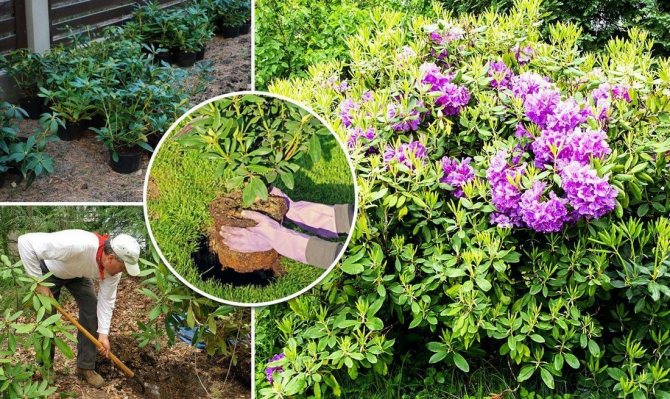

Application in landscape design
Of course, such a flowering shrub is very popular with landscape designers and ordinary gardeners. It is widely used for single landings and in various compositions.
Often, bush azalea is used to decorate parks and squares, gardens and balconies. It looks very harmonious in combination with conifers, heather, ferns and rogers.
The lawn looks exquisite, where several varieties are planted with a contrasting color of flowers and different flowering periods. It is not recommended to place the azalea next to tall plants so that they do not obstruct the access of light and do not obstruct its beauty.
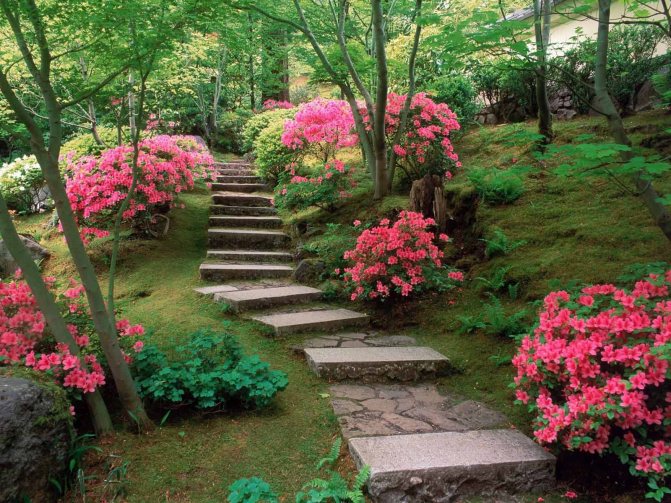

How to identify a deciduous variety
Rhododendron yellow: deciduous, pontus azalea
One of the differences from evergreen varieties is more abundant flowering. Deciduous varieties have more flower branches than semi-deciduous or evergreen varieties. Another difference is the riot of autumn colors on the leaves of deciduous varieties.
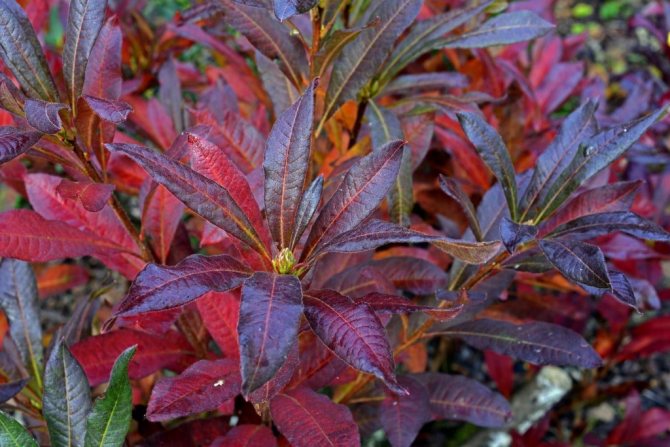

Autumn colors riot on deciduous varieties
With the arrival of autumn, the leaves change color from fiery yellow to crimson red. The decorativeness of the bush from spring to late autumn remains at a height. These exotic plants do not grow too quickly, they lend themselves very well to pruning and decorative crown formation. The frost resistance of the bush also affects the choice towards deciduous.
Attention! Residents of Siberia and the same harsh climatic zones should think about hiding a rhododendron for the winter.
Deciduous varieties are less picky about the conditions of detention and are more hardy, therefore they are suitable for novice gardeners, future lovers of rhododendrons.
Site selection and preparation for landing
Evergreen and deciduous azaleas prefer well-lit places, but not under the scorching sun, otherwise they will lose buds and dry out the leaves. Lighting should be diffused, but not in solid shade - the azalea may not bloom.
It is necessary to choose a site in the garden, protected from cold winds and from drafts.
These plants prefer acidic soil, loams and calcareous soils are contraindicated for them. If the soil does not meet the requirements, then you can remove the top layer and fill it with fertile and loose soil by 0.5 m instead of it with the addition of peat, sand and coniferous soil.
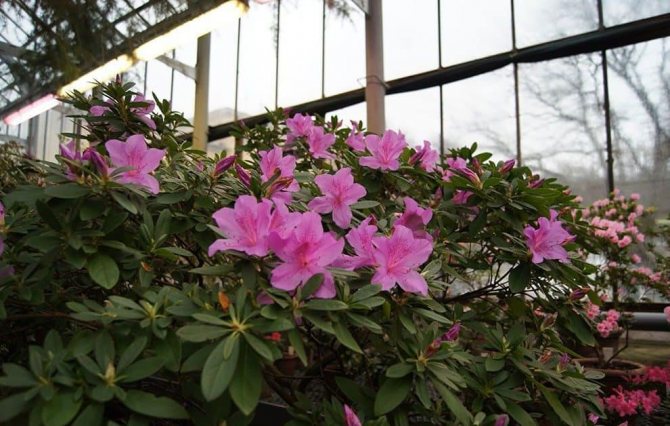

Azalea: lighting, temperature, watering
The indoor beauty welcomes diffused lighting, so at noon it is better to hide it from the zenith. Ideal locations for azaleas are east or west facing windows. If the plant is grown outdoors, then it is better to plant it under sparse trees.
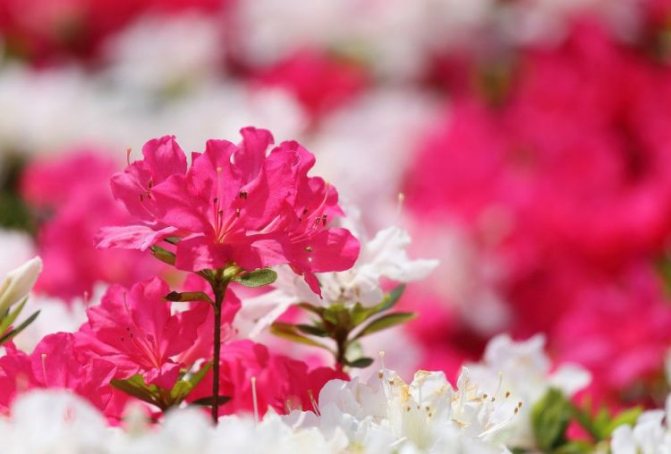

As for watering, it should be regular. Moreover, the azalea must be moistened not only with a watering can, but also with a spray bottle. Spraying can only be abandoned when the azalea leaves are supplemented with flower buds. But watering at the root, especially in summer, should be daily.
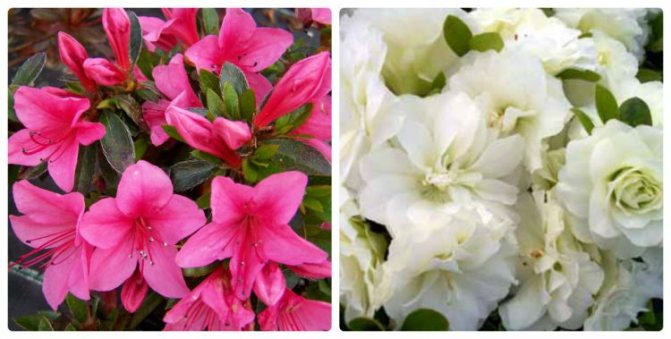

The main thing is that the water is clean and slightly acidic. The last requirement can be met by adding two drops of lemon juice.
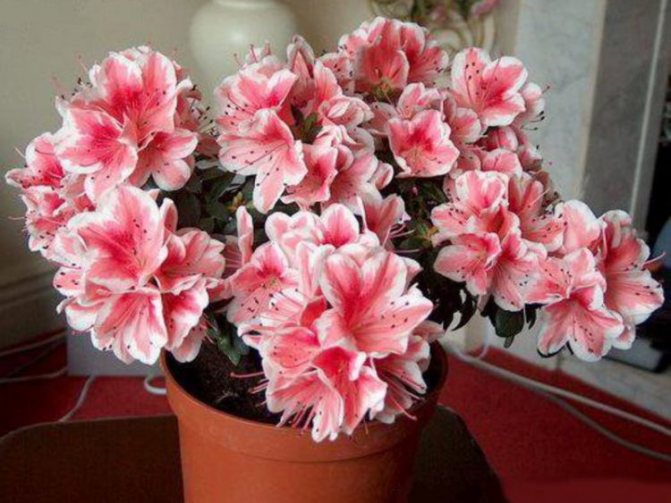

Planting instructions
Planting is best done in spring, when the soil has warmed up and the night frosts have already stopped. The algorithm for planting an azalea seedling is as follows:
- Dig a hole 50 cm deep and 70 cm wide.
- Lay out drainage on the bottom of the pit, consisting of expanded clay or broken brick with sand, with a layer of about 20 cm.
- Place the seedling in the center of the hole and spread the roots.
- Cover with prepared soil and tamp lightly.
- It is good to water the seedling, if the earth has subsided, add more.
- Mulch the trunk circle with fallen needles or moss.
Azalea is a delicate plant that requires compliance with the basic rules of planting and care, then it will reward for the work with a long and lush flowering, pleasing to the eye with its beauty.
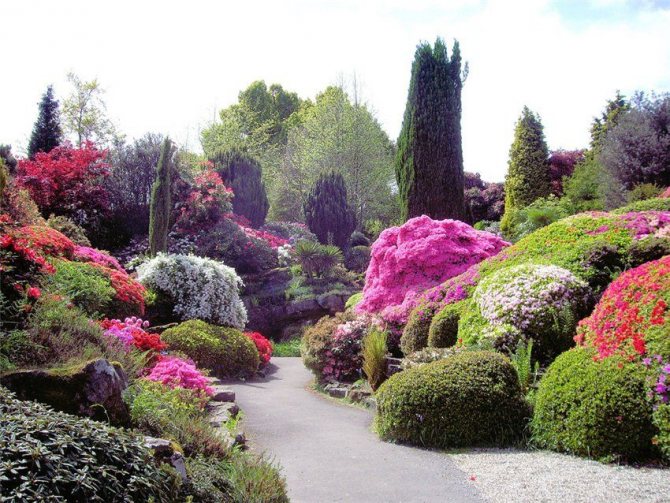

Watering
Azaleas are very fond of moisture, it should be provided in sufficient quantities. But you can't overdo it in watering either.
The most abundant watering is necessary for the plant during the period of bud formation, but at this time it is still impossible to spray, the buds may fall off.
During the period of active flowering, in addition to abundant watering, it is recommended to spray in the morning or in the evening with water at room temperature.
In autumn, watering should be reduced, and in winter, stop, then natural natural moisture will be enough.
Top dressing
Azalea, like all plants, needs fertilization. The first feeding is done in the spring, before the start of the growing season. The bushes are watered with a humus solution.
The second dressing is applied on the eve of flowering. It consists of nitrogen, potash and phosphorus fertilizers taken in equal parts.
The third dressing is done after the end of flowering, and it includes potash and phosphate fertilizers in a 1: 2 ratio.
It should be noted that additions of chlorine and lime have a detrimental effect on azalea. Therefore, ready-made fertilizers must be selected without their presence, and it is also impossible to sprinkle the soil with ash. Top dressing is applied not at the very root of the bush, but departing from it by 20-25 cm.
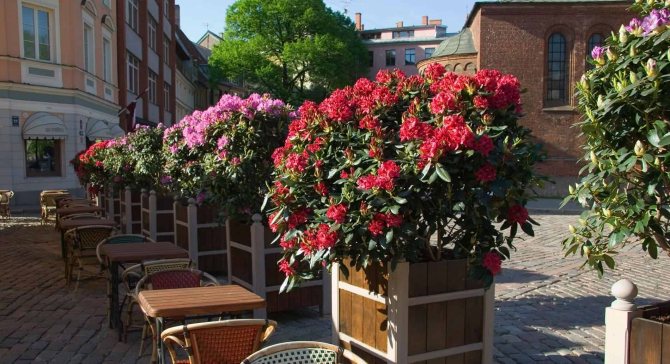

Pruning
For a beautiful appearance of the bush and abundant flowering, it is necessary to prune. After the end of flowering, dry inflorescences, broken off twigs, and excess shoots are cut off, but it should be borne in mind that new inflorescences are formed on annual shoots, so they cannot be cut off.
In the spring, sanitary pruning is performed - damaged and frost-bitten twigs are removed. Places of cuts must be treated with garden pitch, and wash your hands thoroughly, azalea juice is poisonous.
Mulching and loosening
After each watering, it is advisable to loosen the soil to a shallow depth, given that the roots of the azalea are located close to the surface of the earth. Mulching must be done to retain moisture in the soil, to protect against weeds and pests.
Peat, straw, sawdust, coniferous needles, dry oak leaves are usually used as mulch. Care should be taken to ensure that the mulch does not cover the root collar of the plant.
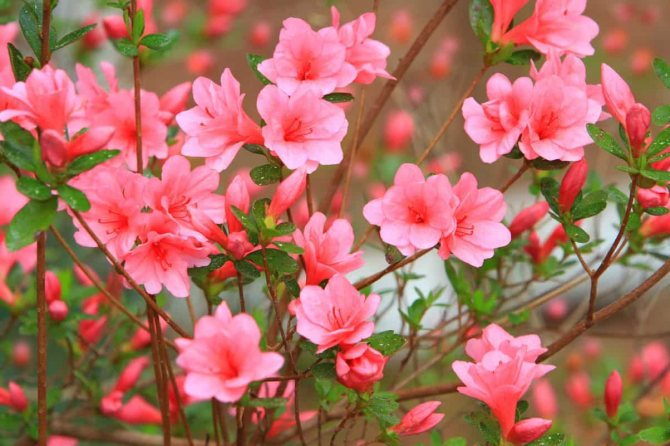

Disease Prevention and Pest Control
Azalea is highly resistant to common diseases. But if you take care of her incorrectly, then some troubles may arise.
For example, if the bush is in a place that is too shaded or too light, there may be no flowering. In this case, the plant should be transplanted to a more suitable place.
If foliage falls, then the soil is not acidic enough, it is necessary to water it with water with the addition of lemon juice.
Of the harmful insects, azalea can be attacked by scale insects, spider mites and mealybugs. If traces of the vital activity of pests are found on the bush, it is necessary to treat the plant with soapy water.
If this does not help, spraying with insecticides should be applied.
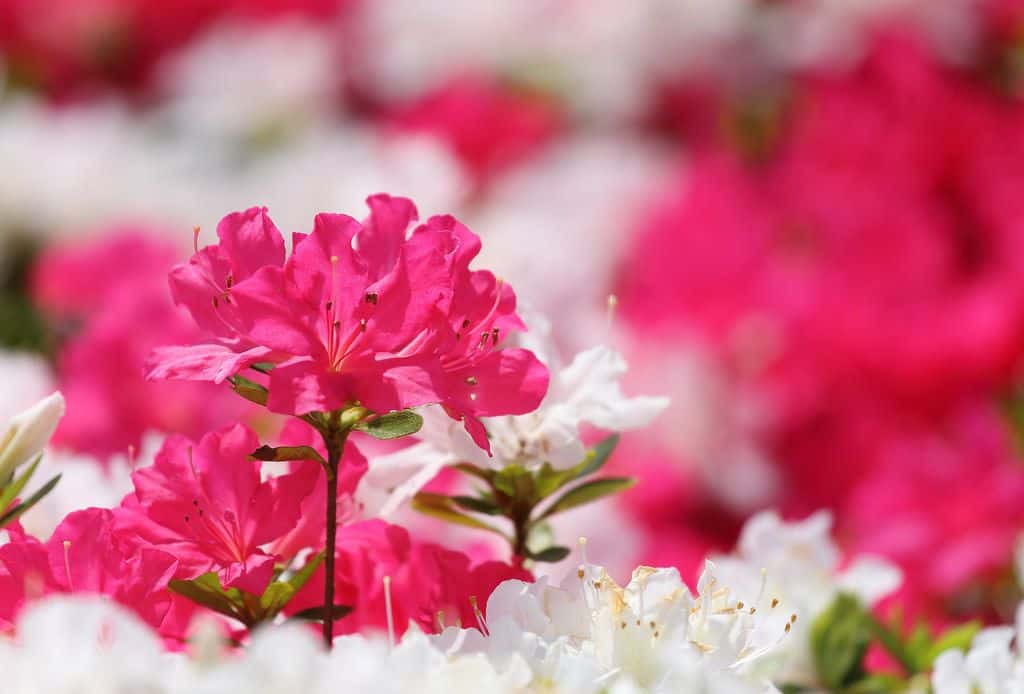

Preparing for winter
The azalea must be covered for the winter. In autumn, before the onset of night frosts, water the bushes abundantly, loosen and mulch.
Low evergreen azaleas are covered with spruce branches, a frame is built over higher bushes and covered with breathable material.
Under deciduous varieties, the soil is covered with dry leaves or sawdust, the azalea branches are tied and bent to the ground, and the top is covered with breathable material, after which the shelter is fixed with staples. In the spring, the building is gradually dismantled.
- View the full image
Azalea is a shrub from the heather family of the genus rhododendrons. The flower symbolizes passion in eastern countries. Evergreen shrubs ranging in size from half a meter to one and a half meters have small, dark green foliage, slightly pubescent. During flowering, the bushes are decorated with simple or double flowers of a rich color range. The flowering period occurs in November-April and lasts 1.5-2 months.Large flowers of various colors favorably emphasize small dark foliage, which can be completely hidden by color. Flowers can be double or simple, with petals arranged in one or two rows. In its natural environment, the plant can be found in European, Asian and North American countries. Initially, azalea was grown in indoor or greenhouse conditions as a winter flowering ornamental shrub. And at the beginning of the twentieth century, breeders bred winter-hardy varieties suitable for planting in open ground in the garden.
Types and varieties of garden azalea
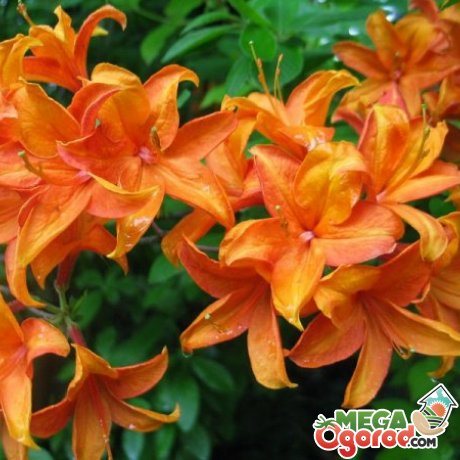

The ancestors of all known varieties are two types of garden azalea:
- Azaleas Indian or Sims rhododendrons. These are medium-sized leaf-shedding shrub-like plants that grow up to half a meter. Young branches and leaves are covered with chestnut or reddish villi. Bushes are covered with small leathery leaves up to 4 centimeters in length. The leaf plate is green, with the inside being lighter than the outside. Indian Azaleas bloom with multi-colored simple or double flowers, which are collected in inflorescences. The color scheme ranges from pure white to bright scarlet shades. Flowers are often two-toned.
Japanese azalea or rhododendron blunt. Japanese or evergreen azaleas are usually grown in the garden because they are more cold-hardy, able to withstand temperatures as low as 20 degrees. These are medium-sized, spreading bushes that begin to bloom in May. This species is distinguished by larger glossy leaves up to five centimeters in diameter and smaller multi-colored funnel-shaped flowers up to three centimeters.
- Esprinzessin (Azalea japonica Eisprinzessin) - the height of the bush is up to 30 cm, and the diameter of the crown reaches half a meter. It blooms in May-June in double open white flowers with a pinkish center.
- Kermesina Rose (Kermesina Rose) - adult bushes reach 80 centimeters in height and a meter in width. The bell-shaped flowers of the variety have a two-color color: bright pink with burgundy blotches. The petals have a lighter edging. Flowering time May-June.
- Kermesina Alba (Kermesina Alba) - differs from the previous variety in milky white flowers that abundantly cover the bush during flowering.
- Adonis is a descendant of mountain azaleas that bloom in May. Covered with glossy elliptical olive-colored leaves, the shrub blooms with snow-white flowers, collected in inflorescences. Azalea Adonis grows rather slowly and lives up to 10 years.
- Geisha Orange - the height of the bush is up to 50 cm, and the width is up to 70 cm. Bell-shaped orange flowers are concentrated at the tips of the branches. Flowering time May-June, duration 2-3 weeks. The crown of the shrub consists of many short shoots that are covered with dark leathery leaves.
- Toreador (Toreador) - one of the most spectacular rhododendrons, which is distinguished by bright purple flowers and bright glossy leaves. This is a semi-evergreen shrub that sheds old foliage, leaving young leaves.A bullfighter can grow up to a meter in height.
- Konigstein (Koenigstein) - has a round-compact crown of green foliage. The bush reaches a height of 0.8 m and a diameter of 1.2 m. The flowers have a lilac hue and densely cover the plant. Blooms in mid-May.
- Goldtopas (Goldtopas) - low bushes with beautiful bell-shaped flowers of bright yellow shades.
- Raimund (Raimunde) - blooms with strong-smelling pink flowers with orange spots. Blooms late.
- Sunte Nectarine - flowers collected in inflorescences resemble a shaggy golden ball with red strokes. Each individual flower consists of orange wavy petals surrounding a red corolla.
Care after planting, pruning rules
Taking care of an Asian guest is not too difficult. When handled with care, the luxurious exot will give you a long and bright bloom. Correct care is based on regular abundant irrigation, periodic spraying of foliage. Water for irrigation should be soft, settled, warm. Use rainwater or pond water. If this is not available, soften it by adding a little peat a day before watering. The exotic is very hygrophilous, but it will not tolerate the cultivation of the swamp.
Watering must be carried out in small portions, as soon as the top layer of the earth dries up. It is especially important to maintain irrigation during the budding and flowering period. It is useful to acidify the soil monthly when watering, using the juice of 5 lemons, dissolved in 5 liters of water. An adult bush will need 2.5 liters of such liquid, and a young one was flogged with 1.5 liters.
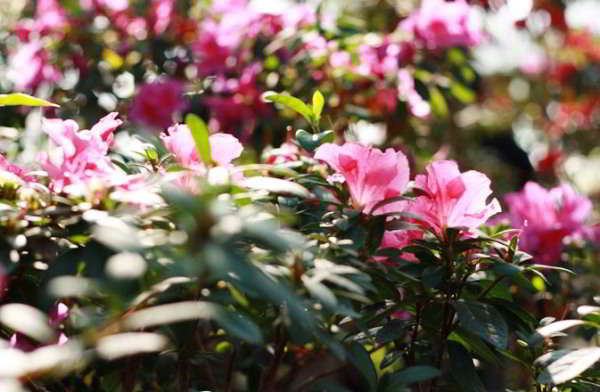

By the end of August, gradually reduce irrigation to slow down growth and speed up maturation of the wood. Watering in the fall is carried out only in the absence of natural precipitation for a long time.
On a note! The lack of moisture in the soil can be judged by the change in foliage turgor. Loss of shine and drooping of the foliage is a signal for urgent watering.
To prevent the plant from suffering from rapid evaporation of moisture and overheating of the roots, be sure to mulch the trunks. Mulch must be refilled periodically. Loosening after watering is unacceptable, because the most delicate network of roots lies in close proximity to the surface of the earth. Because of this, you cannot use a hoe for weeding, remove the weeds by hand.
Azalea will bloom more magnificently with timely fertilization, but it cannot be overfeeded either. Nitrogen in the form of mullein is applied only in early spring. It will help you wake up from sleep and start building up green mass. In further fertilizing, this microelement should not be, otherwise you may not wait for flowering, but the bush will become much more magnificent. Apply potash fertilizers such as potassium nitrate before flowering. Feed the shrub for the last time in mid-July using phosphorus complexes.
Remember! It is unacceptable to add wood ash - it will shift the pH level to the alkaline side, which will cause chlorosis of the foliage. Lime formulations and fertilizers with chlorine will lead to the death of the plant.
A feature of rhododendron is that pruning is not an obligatory measure, because the tree is able to independently form the correct crown. If there is no need to thin out the crown or slightly reduce its splendor, then the haircut is carried out in early spring. It serves to reorganize the bush.
In this case, all damaged and frozen branches are removed, a sick, weak growth is cut out. Sections thicker than 2 cm are treated with linseed oil, garden varnish. Rejuvenation is carried out in two stages, cutting out half of the branches at a height of 40 cm. The second part is removed in the next season. Do not forget to be careful when cutting, because the plant sap is poisonous.
Since rhododendrons bloom on last year's shoots, formative pruning is carried out after flowering so as not to affect the flower buds. Remove wilted inflorescences and adjust the crown without affecting the young growth.
Exot is susceptible to fungal diseases, rot, spots, rust. They arise with improper agricultural technology and sharp fluctuations in the temperature background. Spring treatment with Bordeaux liquid will help protect the bush from the attack of fungi. If you find signs of disease, treat the bushes with a fungicide solution.
Important! Chlorosis of foliage is manifested by a weakening of the color of the plates. Adjust the acidity of the substrate by adding peat or watering with lemon water.
If pests are detected - aphids, thrips, spider mites, mealybugs, spray the bushes with a systemic insecticide.
Preparing the seedling and planting site
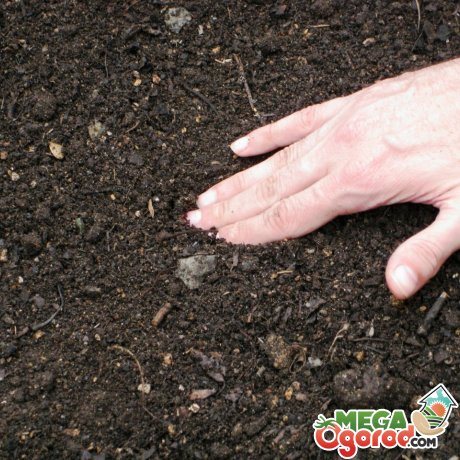

For a garden azalea, a slightly shaded place in the garden is ideal, because the plant in nature prefers to grow in mountain woodlands. When choosing seedlings, the following points should be considered:
- the earthen lump should be moist and large enough. If there is not enough substrate, then the root system can easily suffer when transplanted into the ground.
- the branches should have a healthy appearance, and the plant itself should sit firmly in the ground
- it is better to purchase seedlings in a specialized store, then information about the variety and features of planting and care is attached to the purchase
Before planting, the plant should be watered abundantly so that it can be easily removed from the container.
Garden azalea prefers loose acidic soil, consisting of coniferous or turfy soil with an admixture of peat and sand.
To keep the acidity of the soil at the desired level, you should periodically add a little citric acid to the irrigation water. Also, the soil must have good cultivation capacity and at the same time retain moisture.
Garden azalea - what flowers are friends with?
So that the garden azalea is not lonely, and the flower bed is replete with a round dance of colors, it is recommended to surround the heroine of the theme with the following plants:
- Hydrangea;
- Yew;
- Tuepsis.
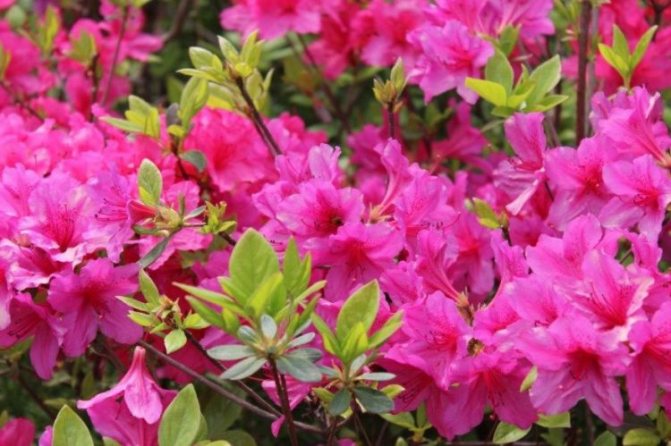

These specimens also love acidic soil and partial shade. But if desired, the azalea can be decorated with petunias, medicinal chamomile, etc. The main thing is that the plants grow in pots. Then they can be rearranged if necessary.
Landing times and rules
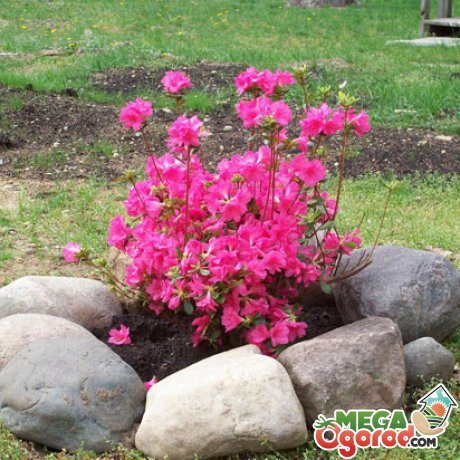

The azaleas are planted in late spring, but seedlings can also be planted throughout the summer and during the warmer months of autumn. The plant has a superficial root system. In this regard, you should not plant shrubs near trees.
When planting, care should be taken that the root collar is not buried in the soil. Disembarkation should be carried out, adhering to some rules:
- the landing hole should be 60x60 cm in size
- at the bottom of the hole, drainage from fine gravel or broken brick is laid with a layer of 20 cm
- fill the hole with a soil mixture prepared in advance
- a seedling is placed in the center of the hole, sprinkled with a substrate and tamped a little
- abundant watering of the plant is made
- after shrinkage of the earth, the soil mixture should be poured into the hole without burying the neck of the plant
- the ground around the trunk is mulched with peat or moss
It must be remembered that the garden azalea loves space, so it is necessary to maintain sufficient spacing between the bushes.
Azalea: choice of soil, pot and care programs
Indoor azaleas love acidic and well-drained soil. To prepare the desired substrate, it is recommended to use:
- Sod land;
- Peat;
- Humus.
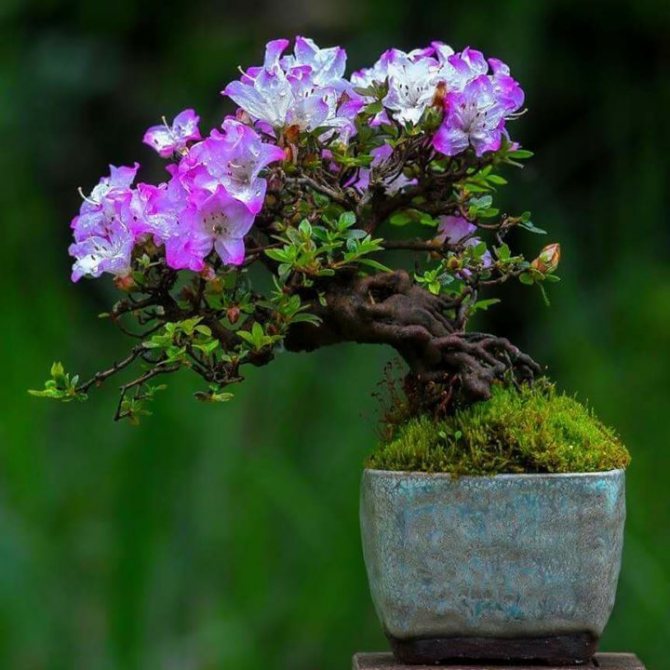

But ash, with its alkaline properties, is contraindicated for a thematic flower as well as a deep container. The height of the latter should be no more than 15 cm, since the azalea root grows superficially.
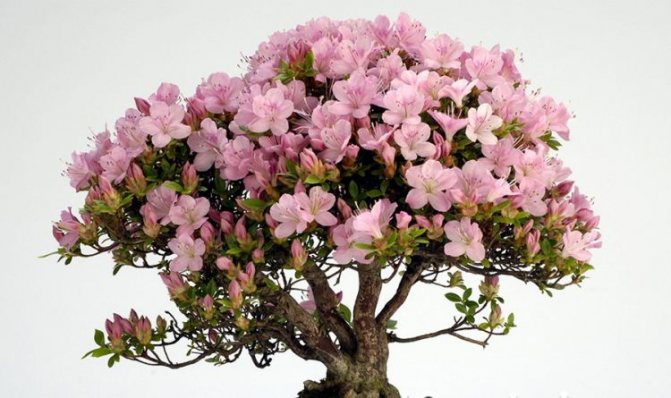

In order for the plant to develop better, its leaves must be cut off once a year. Top dressing is best done with the onset of spring. When the azalea blooms, the temperature of the soil must be lowered with ice.
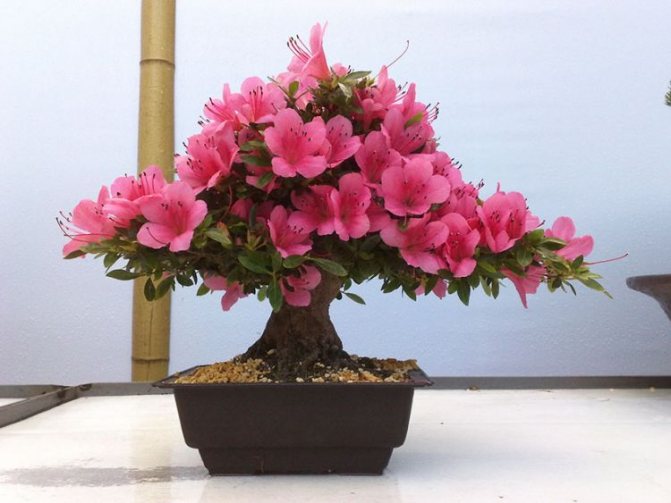

The latter can be filled with a container, which, being next to the plant, will contribute to the appropriate microclimate.
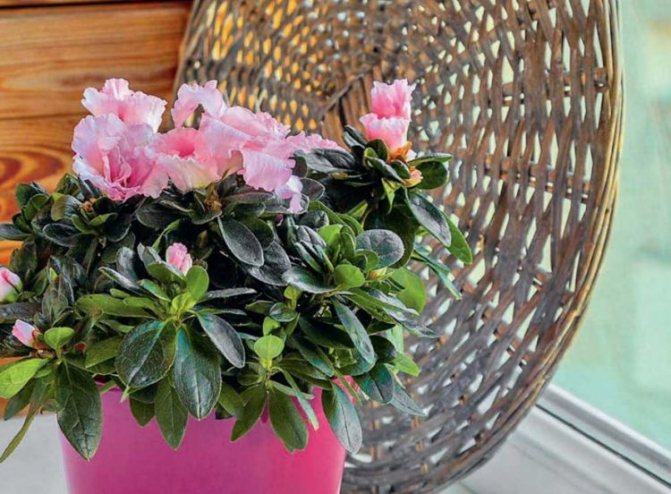

Azalea garden care
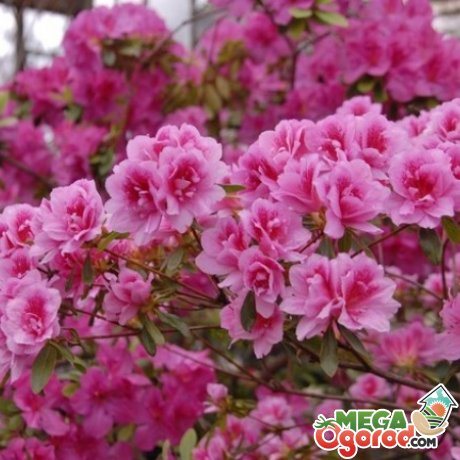

Azalea is quite capricious in leaving and requires special attention. Garden azaleas are very fond of water. In addition to regular watering, you should arrange shower shrubs. It is impossible to bring the soil to dryness, but overflows will not be beneficial to the plant. Azaleas require a special abundance of moisture during the flowering period. Also, plants should not be sprayed at this time, because moisture leaves ugly spots on the flower petals, which spoil the decorative effect.
Important! If the soil in which the azaleas grow dries up at least once, then the plant will drop not only all the blossoming flowers, but also the ovaries.
To provide the plants with the necessary complex of mineral substances, fertilizing with a solution of cow dung should be carried out. This fertilizer should be applied exclusively in the spring.
The next plant feeding is carried out after the end of the flowering period. At this stage, azaleas need potassium-phosphorus fertilizers to recuperate. For adult representatives, complex fertilizers with a long period of action will also be appropriate. You can not make top dressing directly under the roots, you need to distribute the compounds around the bush.
- Pruning of bushes is carried out during the ejection of buds, removing all new shoots. This must be done so that the plant has enough strength to bloom.
- During and after flowering, dried buds and weakened stems should be removed.
- It is also worth thinning the bushes by removing densely growing branches. Thanks to such procedures, the bushes will acquire a neat decorative look for the next year.
To prepare azaleas for winter frosts, deep pruning of the bushes is carried out, in which all weak shoots are removed, and the remaining branches are shortened by a third.
After pruning, the plants should be covered with coniferous spruce branches, which will provide protection not only from the winter cold, but also from the early spring sun, which can destroy azaleas. Before sheltering, the bushes should be well shed and this should be done before the first frost.
Acclimatizing azaleas at home after purchase
Full adaptation of the azalea to new conditions will occur when it fades and gives new shoots. After the purchase, the flower cannot be placed next to heating devices, it does not tolerate heat. The plant needs high humidity, not lower than that which was in the store. During the acclimatization period, the bush does not need to be fed: there are enough nutrients in the transport soil.
Spraying with Epin will help you get used to the new conditions. It activates protective functions, improves stress resistance and immunity of the bush. If the plant begins to wilt and shed its leaves, it needs a transplant. How to make it is described in the chapter "Forming and transplanting a flower".
Reproduction
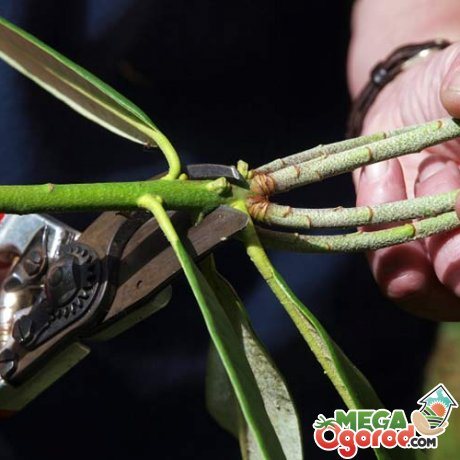

There are three ways to propagate garden azalea:
- Seed method. The longest way. Plants are planted in the ground only the next year after sowing the seeds. The seed is sown in greenhouses and germinated in the prepared soil, the grown seedlings are planted in separate containers.
- Cuttings. For this, a developed stalk with two or three leaves is separated. The cut site is treated with a growth stimulant and the cutting is placed in a peat mixture at a 45% slope. From above, the cuttings are covered with polyethylene material. Further care consists in regular watering and spraying.
- Division of the bush. In the spring, the bushes are neatly divided in half. Both halves must have a developed root system and at least two shoots. the separated plants are planted.
Top dressing
Azalea should be fed at least 3 times a year with fertilizer suitable for plants that prefer acidic soils. It is important to choose the right moment here. To avoid the annoying shedding of the bush, top dressing is applied no earlier than flowering begins. Stop feeding rhododendron 2 months before the first frost on the ground, so as not to harm winter hardiness.
Azalea will perfectly respond to watering in early spring with infused mullein. Before flowering, the plant, in addition to nitrogen, will equally need potassium and phosphorus. At the end of wilting, watering is carried out with a mixture of one part of phosphorus and two parts of potassium fertilizer. It is important to know that rhododendron will not transfer lime and chlorine in the fertilizer. It is also unacceptable to add wood ash as top dressing.
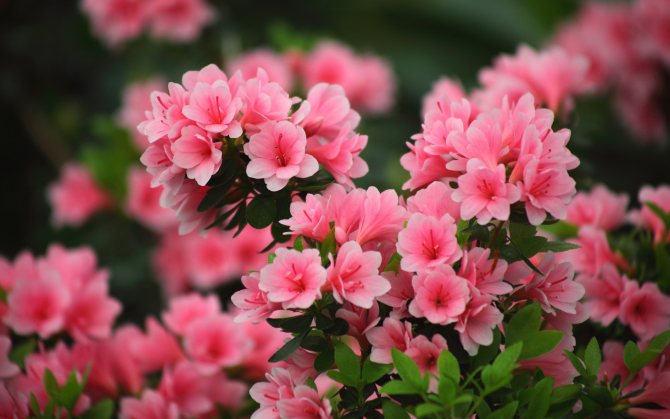

Bloom
When and how does it happen?
In gardens, front gardens, azalea blooms in spring, starting from March - April, depending on the variety. Most Japanese azaleas begin to bloom in May or early June. In apartments, with proper care, you can see lush bloom even in February.
This wonderful flower blooms very profusely, the flowers completely cover the surface of the crown so that the leaves are not even visible. With the correct formation of the bush, the Japanese azalea looks like a large, densely blooming ball., hemisphere, cloud.
What should be done before and after this process?
Important! Do not spray during the active period of flowering - ugly age spots appear on the flowers.
During bud formation, the temperature should be reduced to 10 ° C. Already during flowering, the temperature can be increased by 5 degrees. During flowering, a lot of light is required, just not direct sun, but scattered one.
Pots and containers can be rearranged and unfolded during flowering to adjust temperature and light - the Japanese azalea tolerates “crossings” well.
After flowering, young, elongated shoots of azaleas are pruned for further propagation and the formation of a beautiful bush.
If not blooming
So the azaleas are hot or lacking moisture.
- It is necessary to rearrange the flower in a darker place, shade the glass of the balcony, adjust watering, cover the flowerpot with ice, add spraying of foliage or a shower in the summer.
- You can feed with fertilizers specifically for this type of azalea.
- It is imperative to look for the presence of parasites and pests, they usually inhibit the growth and flowering of the delicate azalea.
In order to prolong flowering, you need to constantly clean the flower from already wilted flowers.
Where to plant deciduous rhododendron
Rhododendron Katevbinsky Grandiflorum
When choosing a place where a shrub grows, you should consider:
- Rhododendron does not like sunny open areas. The terrain should be partially shaded. An option is possible when half of the day the bush is lit, and the rest of the day is in the shade. In winter, shade should also be in order to avoid diaper rash on the branches and root collar.
- It is important to shield the bush from the wind, but a fresh air flow is essential for full growth.
- The shrub will quickly die in a place where stagnant water will periodically form. Breeders recommend planting the bushes slightly on a hill so that water does not linger at the roots during rains and melting snow.


